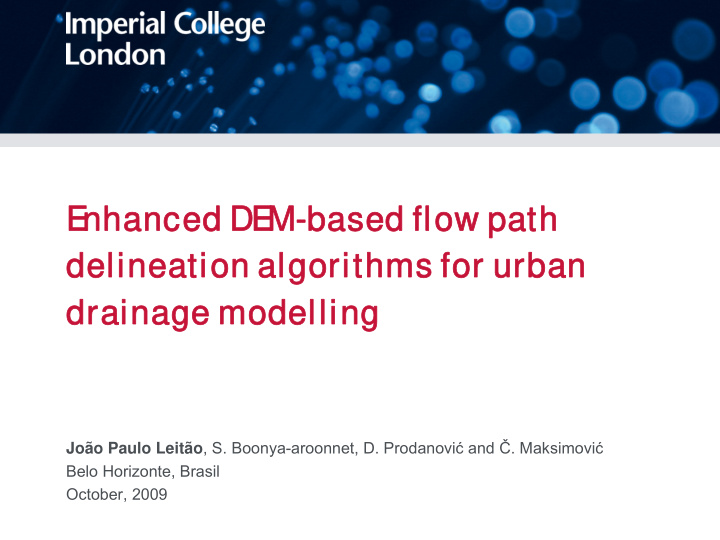



E E nhanced DE nhanced DE M-based flow path M-based flow path delineation algorithms for urban delineation algorithms for urban drainage modelling drainage modelling João Paulo Leitão , S. Boonya-aroonnet, D. Prodanovi ć and Č . Maksimovi ć Belo Horizonte, Brasil October, 2009
O utline Urban Flood Modelling (UFM) Dual-drainage concept DEMs and overland flow path delineation DEMs and overland flow path delineation problems Advanced flow path delineation methods Results Conclusions
Urban pluvial flooding (background) Extreme rainfall events! Poor drainage management Overloaded drainage system Processes on the surface Ponds developing; Moving over long distance using preferential routes (streets, canals); Interacting with subsurface (sewer) system.
Need for advanced urban drainage models
Dual-drainage concept Dual-drainage concept (1D/1D and 1D/2D) Sewer system (manholes and pipes). Overland system (depressions and flow paths). 1D overland flow modelling Overland system consists of nodes (ponds) and links (flow paths), generated using DEM. 2D overland flow modelling Surface divided into small elements (squares or irregular triangles), the flow equations ( St. Venant ) are based on terrain characteristics derived from the DEM.
DE Ms and overland flow path delineation DEMs availability SRTM | Contour | Photogrammetry | InSAR | LiDAR | Truth surveys (increasing accuracy and resolution) DEM errors can be due to errors during the elevation acquisition techniques, interpolation methods, etc… Pit cells and flat areas (they can also be real terrain features) DEM resolution and urban pluvial flood modelling Between 1 and 5m (in order to represent the urban features, such as buildings, street curbs)
DE Ms and flow path delineation problems DEM errors Flow path delineation problems Conventional flow path delineation algorithms stop when a pit cell or a flat area is reached
F low path delineation algorithms Rolling ball algorithm (Prodanovi ć , 1999) Flow path completeness problem Bouncing ball algorithm (Boonya-aroonnet et al., 2007) Urban features crossing problem Three advanced approaches to solve the two problems of conventional algorithms are proposed: Bouncing ball and buildings algorithm Bouncing ball and A* algorithm Sliding ball algorithm
Synthetic Digital E levation Model 150 columns and 100 rows 1 obstacle to the flow (building) 1 flow path starting point
Results obtained using the conventional methods Rolling ball algorithm (Prodanovi ć , 1999) Flow path stops near the building (pit cell) – incomplete flow path This method is not appropriate to urban areas where buildings and other man-made features can create small pit cells Bouncing ball algorithm (Boonya-aroonnet et al., 2007) Flow path continues after the small pit cell But flow path crosses a building, i.e. representation of the flow path is not realistic
Results and discussion Bouncing ball and buildings algorithm Flow path does not stop near the building (pit cell) Flow path does not cross the building But, flow path is significantly diverted from the building: is this what is reported in reality???
Results and discussion Bouncing ball and A* algorithm Flow path does not stop near the building Flow path does not cross the building AND flow path goes around the building! this result seems similar to what is observed in reality!!!
Results and discussion Sliding ball algorithm Flow path does not stop near the building Flow path does not cross the building And flow path goes around the building! The result obtained using the algorithm is identical to that obtained using the Bouncing ball and A* algorithm The difference is associated with the different way the algorithms work
Results and discussion What is the best algorithm? There is no best algorithm but... The three advanced algorithms presented guarantee the completeness of the flow path delineation and avoid crossing obstacles Length Flow path delineation Cross Complete? algorithm obstacle? (m) 64.3 No - Rolling ball 148.7 Yes Yes Bouncing ball 155.9 Yes No Bouncing ball and buildings 157.8 Yes No Bouncing ball and A* 173.9 Yes No Sliding ball
Case-study (preliminary results) Location: Lisbon (Portugal) Area: approx. 100ha Land use: highly urbanised
Case-study (preliminary results) Rolling ball (a) Bouncing (b) Bouncing ball ball+ buildings (c) Bouncing (d) Sliding ball ball+ A*
Case-study (preliminary results) Rolling ball (a) Bouncing ball (b) Bouncing ball+ buildings (d) Sliding ball (c) Bouncing ball+ A*
Conclusions Urban Flood Modelling Need to accurately consider surface water phenomena DEMs can be used to support such models (1D or 2D models) DEM availability and resolution High-resolution DEMs (e.g. LiDAR) are becoming increasingly available Highest resolution means higher number of DEM errors (pit cells and flat areas) DEM-based flow path delineation algorithms are severely affected by DEM errors Flow path delineation stops if a pit cell or flat area is reached Urban features (e.g. buildings, etc.) can halt the flow delineation process
Conclusions Advanced flow path delineation algorithms Three novel improvements were developed The results obtained (with synthetic case) and the initial results obtained with one real case show significant improvements Completeness problem of flow path is solved Flow paths crossing urban features problem is also worked out
E E nhanced DE nhanced DE M-based flow path delineation algorithms for M-based flow path delineation algorithms for urban drainage modelling urban drainage modelling Thank you for your attention j.leitao@imperial.ac.uk
Recommend
More recommend